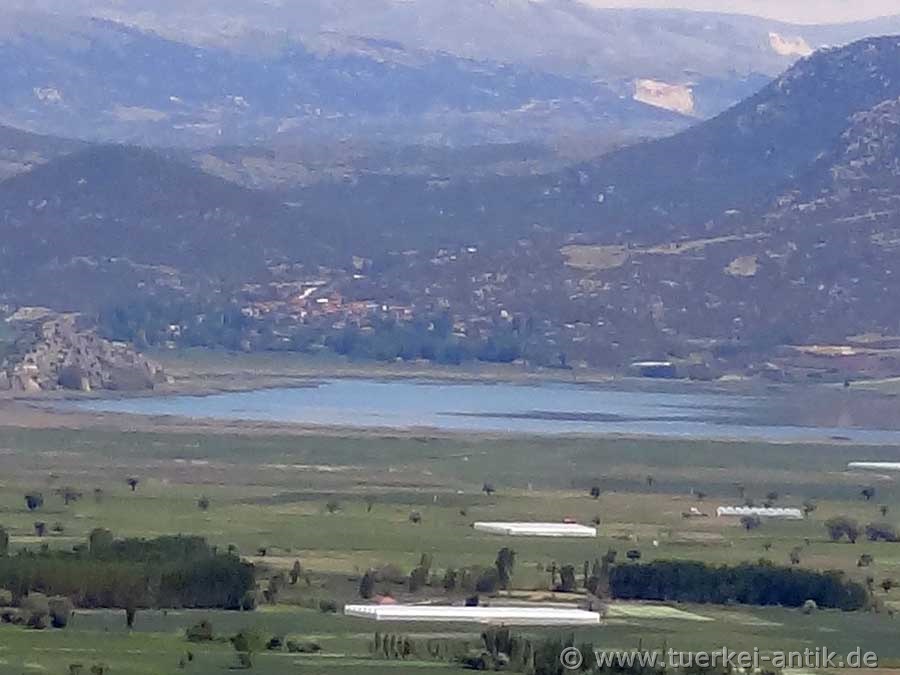 |
| Kibyra in Phrygia | |||
|
|
|
||
| Antique street to the city | |||
|
Kibyra was an ancient city in the south of Phrygia, on the border with Lycia. In contrast to the "little" Kibyra in Pamphylia, the city was also called "the big Kibyra".
|
|||
|
|
|||
| The Stadium | |||
|
Today, extensive ruins bear witness to the former size of the city, including a theatre, an Odeon/Bouleuterion and a stadium recently uncovered. |
|||
|
|
|||
| The colonnade road below the Agora | |||
|
The foundation by Sparta is legendary. In Late Hellenistic times, Kibyra led a four-town alliance (Tetrapolis) to which Balboura, Bubon and Oinoanda belonged. This was dissolved around 84-82 BC by the Romans under Lucius Licinius Murena. Kibyra then belonged to the Roman province of Asia, briefly between 56 and 49 BC to the province of Cilicia, since Diocletian to the province of Caria. |
|||
|
|
|||
|
Magnificent gate on the colonnaded road |
|||
|
|
|||
| Gölhisar, in the background Gölhisar Gölu | |||
|
The ruins of the city are 3 km northwest of the present village of Gölhisar (formerly Horzum). |
|||
|
|
|||
|
The Theatre |
|||
|
|
|||
|
The theatre of the ancient city of Kibyra was built on a natural slope. In Roman imperial times it was provided with a two-storey stone stage house. The stage house is largely destroyed; the components visible today come from the second floor. The cavea is divided into three ranks, each separated by a diazoma. The back wall of the upper diazoma shows a series of inscriptions. On the south side of the theatre a vaulted entrance leads to the lower diazoma . The size of the theatre of one can guess the former size of the city. It is divided into three spectator terraces and had a capacity of about 15,000 seats. The originally Greek theatre was provided with a stone stage house in Roman times. Several inscriptions of honour have been preserved on the back wall of the upper diazoma. The part of the stage house that is visible today is already the second piecework. The lower part is still hidden under debris and sediments. |
|||
|
|
|||
| The Odeon / Bouleuterion | |||
|
A special archaeological "delicacy" is the 3,600-seat Odeon, which was probably also used as a bouleuterion (town hall). In 2009, when the Odeon was uncovered, the floor covering of the orchestra, which had been buried for over 1800 years, was uncovered on the semicircular surface in front of the audience circle. It is an elaborate mosaic of thin, coloured marble slabs. In 2011 another large mosaic was found on the forecourt of the Odeon. |
|||
|
|
|||
|
|
|||
|
Gölhisar Gölü, 10 km away, left of the settlement hill of the previous Lydian settlement |
|||
|
|
|||
|
Since 1995, the University of Vienna Institute for Ancient History and Archaeology has been conducting epigraphic surveys in Kibyra and the western province of Burdur, known as Kibyratis. In 2008 a more archaeologically oriented field research project was started together with the LMU Munich, Institute for Classical Archaeology. In the course of this research, the apparently Lydian predecessor settlement of the Hellenistic Imperial Kibyra could be identified with a primarily archaic settlement site located about 10 km from Gölhisar on a rocky peninsula at Gölhisar Gölü (Gölhisar Lake) near Uylupinar. New excavations by the University and the Museum of Burdur are currently underway in the imperial city area. |
|||
| Photos: @chim | |||
| Translation aid: www.DeepL.com/Translator | |||
| Source: Wikipedia and others | |||
|
|
|||


